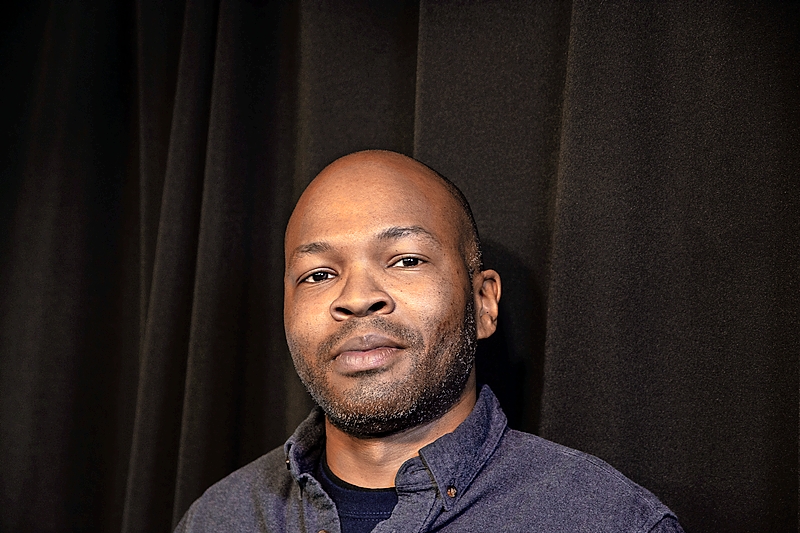Going their own way
By Lisa Arnett
October 2022 View more Featured
Three local entrepreneurs share their startup stories
Great things can happen when you follow your passion. Here, three west suburbanites—a hair stylist with her own product line, a hyperlocal podcaster with a passion for social justice, and a former financial services exec working to transform the industry—talk about the paths that led them to found their own businesses.

The Beauty Mogul
Trayce Madré
With a bustling business in downtown Naperville at Salon Lofts, Trayce Madré is a sought-after hair stylist who has worked on set for TV shows and music videos and has launched her own line of hair care products called Restore by Trayce Madré.
Finding her calling Madré, 44, was raised in the south suburbs and graduated from Rich East High School in Park Forest. She didn’t began pursuing her passion until years later, when she was married with three kids and working an office job. She found herself thinking about her former side hustle of hair styling out of her college dorm room. “I had always been doing hair, but I never saw it as a career,” she says. She slowly earned her hair styling license and started styling hair out of her home and then a shared-space salon in Olympia Fields. She made $14,400 her first year and $22,000 the next. Times were tough, and she and her family had to move into her parents’ house at one point. With every client, Madré saw how a great hairstyle could change their entire outlook. Those early days lead to her creating her own technique of adding sew-in hair extensions, which has been a staple of her business for years.
Building her business What happened next was pivotal in Madré’s career. “My father said—and this still sticks with me—‘You’re over there doing hair instead of running the business. Where’s your cards? What’s your business plan?’ ” He gave her his old computer, and she made a makeshift desk out of a microwave cart. “I thought, What sounds creative? And I literally changed my name on my business cards [from Traci Madré King] to Trayce Madré. I cut my own hair, colored it blond, and I put my face on the business. I thought, What do I want to make in a month? How many people is it going to take? So then I went into the salon with a plan. I thought, Who is my target person? If she is going to pay $250 for her hair, she has to have a job.” So Madré made a flier that looked like a train ticket and handed it out to commuters at Metra stations. “My husband was my street team.” That year, she made $40,000 and was left wondering what it would take to make $80,000 the next.
I am not where I am because I’m great at hair.
I’m where I am because I care for people.
Giving herself credit Madré’s client base continued to grow, and she started to see clients from Chicago coming to the south-suburban salon for appointments. “I took money we did not have to finance a credit-card machine. People who have money spend with credit cards; they were not paying with cash.” The move to plastic paid off, literally. “I was on pace to make six figures that year.” She secured a $12,000 loan to invest in her business. “I went across the street and opened my first salon at under [age] 30.” A local recording artist came in for hair styling, which led to gigs on music video sets. Madré did $624,000 in business the first year in her new location, and the momentum continued to build. Her husband quit his job to help build the salon business, and Madré began to travel for styling gigs in Los Angeles, New York, and elsewhere.
Meeting Michelle Williams In 2012 Madré got a call about Destiny’s Child singer Michelle Williams. “They said she was going to be in town for a speaking engagement and she did not have a stylist.” As Madré nervously worked on Williams’s hair for the event, she decided to shoot her shot. “I said [to Williams], ‘If I could have the opportunity to try my [hair extensions] technique on you, I have an amazing hair line.’ I personally didn’t like [the extensions Williams] had, and it turned out, she didn’t either. Can you believe she gave me her address and home phone number? I ended up going there, and she loved it and she has been calling me ever since.” Madré has styled Williams’s hair for appearances all over the country—including her 2013 Destiny’s Child reunion performance at the Super Bowl—and credits Williams’s social media shout-outs for helping her gain recognition in the industry.
Launching a product line With a booming salon and busy styling schedule, Madré then set her sights on creating her own line of hair care products. “One of the big fallacies is that there are products per culture. It doesn’t have to do with ethnicity; it has everything to do with texture,” she says. “If you’re white with wavy hair, well, I have wavy hair, we can use the exact same product.” She began the formulation process for Restore by Trayce Madré in 2014. After a year and a half of tinkering and testing, she started selling her five-piece hair care collection in her salon in 2016. Her vegan, cruelty-free products are now sold on Amazon’s and Walmart’s web sites as well as her own, restorerxbeauty.com.
Burning out and retiring In 2017 Madré moved her business to Naperville. She was working 20-hour days. Though her nonstop schedule was financially rewarding—the business made $1.2 million that year—it wasn’t sustainable. “What I would say now is you cannot physically keep up what I was doing.” By the next year, she was so exhausted she decided to retire. “I had a full, live announcement. I cut my hair. I gave all my equipment away. I was done.”
On her return Madré switched gears to work in sales but felt unfulfilled. While she was out for a birthday dinner with her husband in 2019, a fellow diner approached. “She said, ‘Are you Trayce Madré? I was saving up to get to you!’ And it broke me for real,” she says. “I burst into tears. I told my husband I thought I had made the biggest mistake and I don’t know how to fix it. He said, ‘Why don’t you just go back and try it and see?’ ” She started quietly seeing clients out of her former assistant’s salon space that November and by December had signed a lease for Salon Lofts. Just weeks into the new year, she was booked through August.
Working with celeb clients In addition to Williams, Madré has styled supermodel Beverly Johnson, TV personality Angela Simmons, and author Rae Lewis-Thornton. ABC-7 host Val Warner is featured in one of Madré’s latest video promotions. “When you’re dealing with [celebrities], you’re dealing with their career, their look, how they present themselves. That is huge. It’s a heavy responsibility, and most people think it’s all glitz and glam.” Her hairstyles have appeared in Essence, Allure, and Sophisticate’s Black Hair. In 2021, Madré was featured in Forbes’ “Next 1000,”which the publication describes as a list of “upstart entrepreneurs redefining the American dream.” That sounds spot on.

The Citizen Journalist
Curtis Spivey
The 40-year-old Aurora resident is the founder and creator of Good Morning Aurora, a pandemic-born hyperlocal podcast and morning show covering news, culture, and community goings-on. Spivey is also a social justice advocate and military veteran. He works full-time for the Neighbor Project, an Aurora-based nonprofit that helps low- and middle-income families work toward buying their first home.
His longtime news obsession “My whole life, ever since I was a young man, I have been a literary and audio and news junkie. I was always, always in front of the news,” Spivey says. “News came before cartoons! I grew up reading Reader’s Digest and listening to NPR. I always wanted to know what’s going on.”
In the navy and beyond Spivey was born in Chicago and raised in Harvey. After graduating from Waubonsie Valley High School, he joined the U.S. Navy and served as a boatswain’s mate stationed in San Diego. Following three years of service, he moved back to the Naperville area, signing up with a staffing agency that placed him in corporate jobs in Chicago. “In a nutshell, I became a worker bee. This is one of the things that veterans talk about a lot. You come back to society and you’re trying to build a new life for yourself and start a family. What I did was chase the sure thing, not what I wanted. I just played it safe. I would keep trying to get a better-paying office job. It was unfulfilling. I was ultimately creatively uninspired.” Tired of commuting, Spivey took a job managing operations at a new escape room called Escape Strategy Aurora. He also started volunteering for the Neighbor Project (which later hired him full-time) and took an internship with 83rd District state representative Barbara Hernandez’s office to strengthen his involvement in the community. He began to outline ideas for a morning show, but with his busy schedule, the idea didn’t go past the incubation phase.
How the podcast was born Spivey’s work and internship came to a standstill when the pandemic hit. Every morning he’d click through his emails, search for rent-relief initiatives, and talk to friends about their struggles keeping their businesses afloat in the early months of COVID. “I thought, What if I made a show where I could represent for my friends who were in danger of losing their businesses? I had all sorts of info coming in about food drives, blood drives, food for the hero health care workers, donate masks here. I thought, I’ve got good information here. So I started recording myself.”
I wanted to be on the radio, but with no training, no degree, no background in it, the idea of a podcast was really the only little thread I could pull on. If opportunity doesn’t knock, you’ve gotta build a door.
Building an audience His technical and reporting skills have grown since those early recordings with an iPhone 4 in his bathroom (for the best acoustics). Good Morning Aurora celebrated its second anniversary in May and has about 1,000 subscribers and 2,000 listens a week, Spivey estimates. The podcast is a for-profit business and earns revenue from advertising and streaming platforms. During Black History Month in February, Spivey was presented with a Mayor’s Award for Black Excellence to honor his work on the show as well as with the Neighbor Project and the Rotary Club of Aurora. In addition to the podcast on Spotify and Apple Podcasts, Spivey now releases a video version of Good Morning Aurora on Facebook Live and YouTube that’s filmed at Aurora Community Television, the city’s public-access TV studio. “It’s where Wayne’s World was theoretically filmed—this is it!” he says. The latest show intro features drone footage of Aurora with voice-over by Spivey’s 10-year-old son, Xavier. It airs 8 a.m. to 9 a.m. Monday through Friday, with Wednesday’s show in Spanish as Buenos Días Aurora hosted by Mireya Banuelos. “I feel that the most important and thought-provoking issues of the day should be discussed in a professional and respectful manner,” Spivey says, “and I want GMA to lead those discussions.”

The Change-Maker
Anita Knotts
Longtime Naperville resident Anita Knotts, 52, left her job as a senior vice president at Calamos Wealth Management last year to launch her own business, Lotus Women’s Institute. As the founder and CEO, Knotts has a goal to attract, develop, and advance women in the financial services field.
Her formative years Born in India, Knotts immigrated to Chicago at age 4 with her family, who later moved to Summit, then Glendale Heights, and finally Naperville when Knotts was in eighth grade. Her memories from Naperville Central High School are less than rosy, but the experience was significant in shaping who she is today. “I was bullied relentlessly—I think I was maybe one of 10 Indian kids in my class of 800,” she says. “There was very little diversity. It was just a horrific experience. I would eat lunch in the toilet stall [in the girls’ restroom].” Her perspective shifted when she headed to University of Illinois at Urbana-Champaign. “In high school, I thought so poorly of myself, but all of these people [in college] were like, ‘You have a lot to offer.’ I never went back to being a victim of any level of bullying.”
Early career lessons Knotts majored in economics and thought she’d apply to law school, but she was recruited by a Chicago stock brokerage. One lesson Knotts learned from that first gig was that sometimes you have to take a step back to move forward. “I hated [working as a broker] and I sucked, but I thought, I am intrigued with this whole thing with financial markets. But I need to work alongside and support a more senior adviser. So in our industry, that is called a sales assistant, and it was probably one of the best moves I made in the early part of my career. I had no qualms about taking a step back.” Her first assistant job was at a firm with zero senior-level women. In her next job, she worked for a female broker for five years. “I discovered that I enjoy talking to clients and being that person who, when everything is confusing and it’s just a whirlwind in their mind, just call Anita. I wanted to be that person.”
Being a big fish in a small pond Knotts started working as adviser at Calamos in Naperville in 2002, eventually becoming part of the senior leadership team during her 18-year career there. “From day one, I loved it. Oh my gosh, I was in my element. I tell women I mentor now, there is nothing great or horrible about a big firm or about a small firm. It just matters where you feel you have the better fit.”
Making change As Knotts embraced her leadership role, two things became important to her: promoting financial literacy and changing the way the industry looked. “I found out that when you are in a position of power, you have the forum to make change. Some people use it and some people don’t.” She launched a project called the Women and Wealth Initiative. “The meetings and presentations were only for women clients, to create a safe space where they can ask questions where they did not feel denigrated. I can’t even put into words—you can’t quantify the feeling when you empower someone with that level of knowledge.” She also made diverse hiring a focus. “I had a hand in hiring black men, gay people, and women of color. As a leader, that’s what I’ve got to do—I’ve got to make change.” She started the Women’s Initiative Network, an internal group for Calamos employees. “For staff, I wanted them to have that safe space to talk about professional development topics: ‘How do I use my voice? How do I negotiate [for a salary increase]?’ Most bosses are not wired to come to you and say, ‘You look like you could use another 25 grand.’ You gotta ask for it.”
Think Oprah Winfrey and the OWN Network—I want to do that for women and financial empowerment. I’m tired of women playing cute when it comes to outsourcing your financial security. It ain’t cute when your husband is six feet under and you don’t know where your checking account is.
Going out on her own In January 2021, she had a light-bulb moment while brainstorming with friends. “I said that I want to see more women and women of color in this industry. I can help firms find women and women of color. I can speak about my own experiences as a woman of color in a male-dominated industry. And that’s how Lotus was born.” Both excited and nervous, Knotts left Calamos and established her LLC that March. “I didn’t know, is this the right thing to do, leaving a stable job when I am sending my firstborn off to college? But the bigger risk for me was turning 60 years from now and not having done it. That petrified me: having regret. And then I took the leap.”
Her mission “I am trying to turn the financial services industry upside down,” Knotts says. “The mission is to attract, develop, and advance women and women of color within financial services. I am calling myself a change-maker—it’s a ripple effect and it’s changing. I talk to women advisors and I coach them. I am also working with firms who are genuinely committed to diversity and inclusion.”
The name Lotus “My Indian heritage is so, so important to me. I was made to feel ashamed of it as I was growing up; now, I’m filled with pride, and I thought, How do I incorporate this into the name of this company? Then I landed on lotus, the national flower of India. The lotus actually blooms from mud. It blooms into something beautiful, but it comes from yuck. I thought, Wow. What a perfect metaphor. It just clicked.”
Photos courtesy of Nichole D. Bruce/Grey Matter Photography, Curtis Spivey, Steve Ewert


